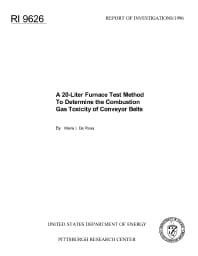Mining Publication: A 20-Liter Furnace Test Method to Determine the Combustion Gas Toxicity of Conveyor Belts
Original creation date: January 1996
Authors: MI DeRosa
NIOSHTIC2 Number: 00233937
Pittsburgh, PA: U.S. Department of Energy, Report of Investigations 9626. NTIS NO. PB96-202619, 1996 Jan; :1-10
The U.S. Department of Energy Pittsburgh Research Center conducted experiments with mine conveyor belt samples in a 20-L furnace and in a laboratory fire tunnel to measure and compare the major toxic gas concentrations evolved during the combustion of the materials. The toxic gas concentrations, measured simultaneously through a multiport sampling device and treated as yield values, included hydrogen chloride (HO), hydrogen cyanide (HeN), oxides of nitrogen (NOx treated as NO2), and carbon monoxide (CO). The data obtained from the two experimental systems were in good agreement. Correlations were developed for the toxic gas yields as a function of the percentage of chlorine (for HO gas), nitrogen (for HCN and NO2 gases), and carbon (for CO gas) contained in the original materials. The toxic gas yields were also used to calculate a toxicity index (TI) parameter to assess the potential gas toxicity of belt materials during a fire. Furthermore, the TI and the mass loss burning rate values were used to calculate a toxicity hazard (TH) parameter to estimate the toxic gas hazard produced by a burning belt in a ventilated system. Results show that polyvinyl chloride (PVC) belts released higher HCl concentrations because of the higher chlorine content; styrene-butadiene rubber (SBR) belts released higher CO, HCN, and NO2 concentrations because of the higher carbon and nitrogen contents. The TI's, however, were greater for the PVC belts due primarily to the higher levels of HCl produced. The fire tunnel data indicate that the SBR belts can burn with higher mass loss rates than the PVC belts, resulting in a potentially higher toxic hazard (higher TH values) even though their TI values were lower than those of the PVC belts.

NIOSHTIC2 Number: 00233937
Pittsburgh, PA: U.S. Department of Energy, Report of Investigations 9626. NTIS NO. PB96-202619, 1996 Jan; :1-10
- CFD Modeling of Fire Spread Along Combustibles in a Mine Entry
- Dangers of Toxic Fumes from Blasting
- Experimental Study of Flame Spread on Conveyor Belts in a Small-scale Tunnel
- Factors Affecting ANFO Fumes Production
- Flammability of Wider Conveyor Belts Using Large-scale Fire Tests
- Impact of Air Velocity on the Detection of Fires in Conveyor Belt Haulageways
- Rapid (Grab) Sampling During Full-scale Explosions - Microscopic and Analytical Evaluation
- Smoke, Carbon Monoxide, and Hydrogen Chloride Production from the Pyrolysis of Conveyor Belting and Brattice Cloth
- Technology News 497 - "You Are My Sunshine": A New Video Release From NIOSH on the Sunshine Mine Fire
- Technology News 549 - MFIRE 3.0 - NIOSH Brings MFIRE into 21st Century